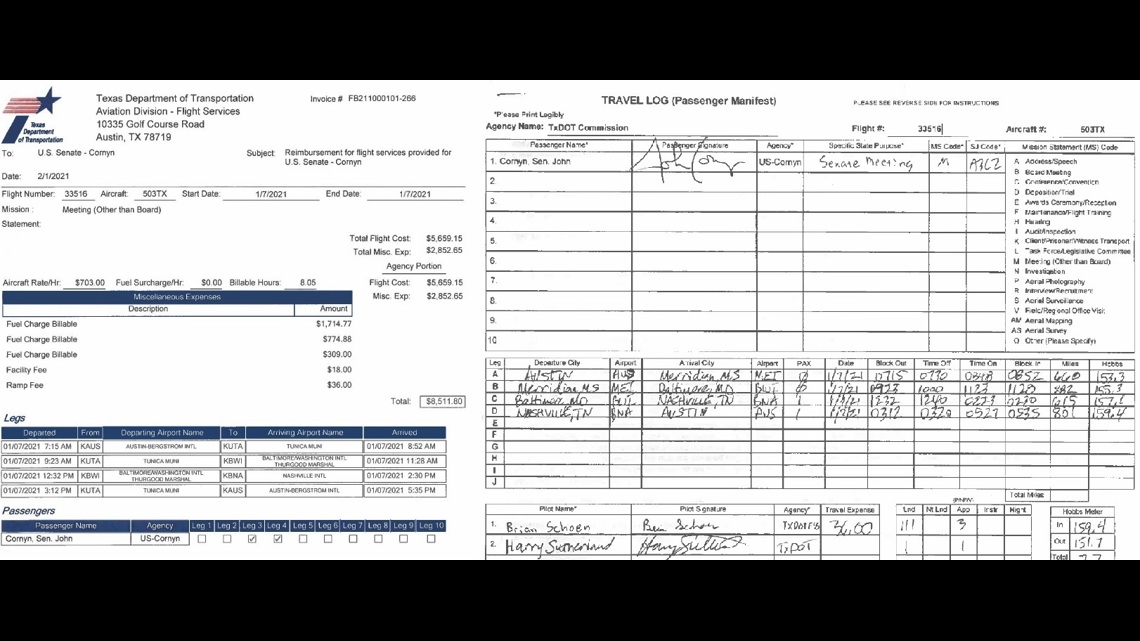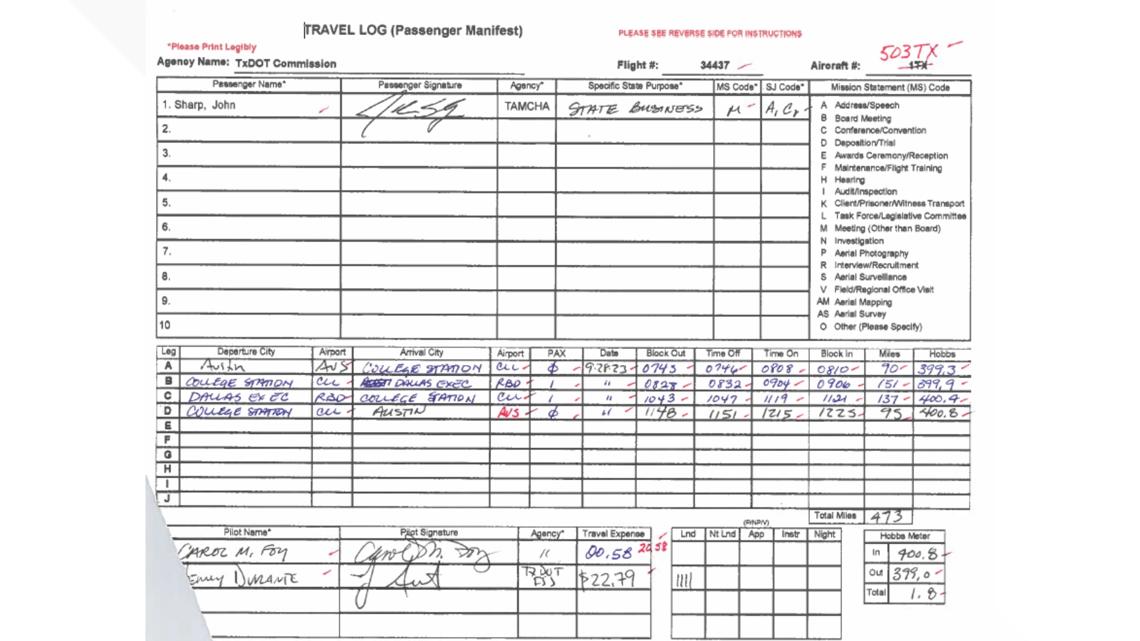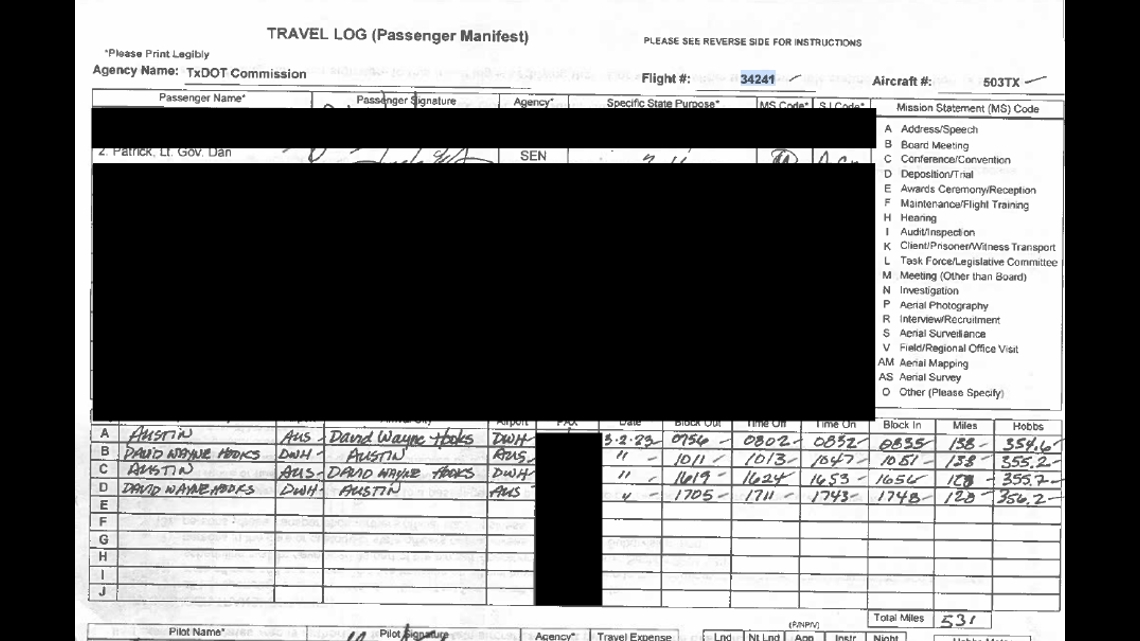HOUSTON — Forget security lines, boarding delays, and the hassle of flying commercial in economy class. Hundreds of Texas state employees and elected officials take advantage of state-owned private jets, but the perk has little oversight, a KHOU 11 investigation has found.
Flights include a high-ranking elected official using private jets several times as an “air taxi” to travel from the Houston area to Austin. Other state officials spent thousands in taxpayer dollars to hop on state planes even when the route was covered by cheaper commercial airlines, according to Texas Department of Transportation flight logs and invoices.
TxDOT attempted to block the release of those records on three separate occasions. KHOU attorneys got involved and it ultimately took 10 months to obtain all the records.
“I think transparency is what’s needed here,” said Adrian Shelley, the Texas director of the government watchdog group Public Citizen. “As taxpayers, it ought to be important to us to see that our dollars are being spent wisely.”
The records reveal the movements of four executive-style jets owned by TxDOT. They offer comfort, convenience and flexible scheduling to quickly shuttle public officials anywhere in the state, as long as the flights meet certain conditions, and the travel is for “official state business.”
Whether those officials follow the rules is left up to the honor system.
“Our role is really to maintain and operate these planes,” said TxDOT spokesperson Adam Hammons.
Hammons repeated that answer seven more times during a 5-minute conversation with KHOU 11 Investigative Reporter Jeremy Rogalski. When asked to clarify who ensures that flights are above board, Hammons offered another response six times:
“It’s the responsibility of any requesting agency or person that’s requesting these flights, it’s their responsibility to validate the state need for these flights,” Hammons said.
Flight rules
State law outlines several reasons when TxDOT-owned planes can be used:
- the destination is not served by a commercial carrier
- the TxDOT transportation is the most cost-effective travel
- the time required to use a commercial carrier interferes with passenger obligations
- a DPS representative determines security concerns warrant a state aircraft
- the number of passengers make the use of a state aircraft cost effective
- emergency circumstances necessitate the use of a state aircraft
Records show most of the flights fulfilled those purposes, including multiple passengers traveling to cities without commercial air service. They included a groundbreaking in Galveston, a presentation in Marfa, a press conference in Uvalde or a disaster site review in Hereford.
“This is a big state. Sure, it’s reasonable that we use a plane to get to certain parts of it at certain times,” Shelly said.
He added that without proper oversight, rules can easily be broken.
“The honor system doesn’t seem to be working. There’s not somebody clearly accountable at the agency, so this seems to be a gap here,” Shelley said.
Cost-effective travel?
When it comes to taking TxDOT flights as the most cost-effective option, there were several questionable flights, including trips from one big city to another with only a single passenger.
Southwest Airlines flies direct from Austin to Lubbock, but State Sen. Charles Perry, R-Lubbock, flew solo from Austin to Lubbock to accept an Outstanding Agriculturalist Award on a state jet. The cost to taxpayers was $3,022.
Or there’s U.S. Sen. John Cornyn, who flew from Baltimore to Austin on Jan. 7, 2021, at a taxpayer cost of $8,511. Part of that hefty price tag was the need for the plane – based in Austin – to fly from Austin to Baltimore empty to pick up Cornyn.


Former Texas A&M University Regent Elaine Mendoza flew alone from Houston Bush Intercontinental Airport to San Antonio at a cost of $2,779.
University of Texas System Regent Christina Crain flew twice from Austin to Addsion in the Dallas area for meetings. The average cost to taxpayers for those flights was $1,954.
A University of Texas System spokesperson said use of a TxDOT plane is reviewed and approved in advance and in compliance with state statutory requirements and regent rules.
“It is used primarily when commercial aircraft precludes or interferes with the regents’ obligations to return home to meet the demands of their work,” said Paul Corliss, associate vice chancellor for external relations and communications.
Shelley said the flight costs are not insignificant.
“And those are resources that could be put to, you know, plenty of other uses, right?” Shelly said. “So as taxpayers, I think we have an interest in knowing that each and every time one of these planes is used, it’s done for a legitimate public purpose.”
Some flights were vague on the public purpose of the flight. For instance, Texas A&M Chancellor John Sharp took a $2,934 round-trip flight from College Station to Dallas and listed the specific state purpose as simply, “state business.”


“When there’s an honor system that doesn’t even ask the most fundamental question about whether this is for public use, you’ve just got a system that is ripe for waste,” Shelly said.
Neither Cornyn, Perry, Mendoza or Sharp’s offices replied to requests for comment.
State plane as an ‘air taxi’
Shelley works in Austin and said when he needs to travel to Houston, he always does so by car.
KHOU 11 Investigates found Lt. Gov. Dan Patrick sometimes takes that trip a different way. He lives in Northwest Harris County, about a two-and-a-half-hour drive from the Capitol and less than 15 minutes from David Wayne Hooks Airport.
Records show on at least three occasions, TxDOT pilots flew from Austin to Hooks to pick Patrick up and then take him to Austin. Hours later, they took the lieutenant governor back to Hooks to drop him off and then returned to Austin all on the same day.


The average cost was about $3,500.
“If they're effectively using, you know, a state plane as a taxi -- an air taxi -- at $3,000, $4,000 a pop, you know, I think it’s fair to ask if that’s the best use of state dollars,” Shelley said.
There were several other flights where Patrick was picked up in Hooks but he continued to another destination or did not return to Hooks that same day.
“Lt. Gov. Patrick almost always travels by car to and from his Houston-area home to Austin,” said Steven Aranyi, Patrick’s press secretary. “He uses a state plane very sparingly for that trip, and always for state business work in compliance with the law.”
Whether Patrick or any other public official is following the law is up to their own offices, TxDOT’s Hammons reiterated.
When asked, “Is anybody looking at these flights to see if they’re above board?”
Hammons answered: “It is their responsibility to validate the state need.”
When asked, “And if rules are broken, rules are broken?”
Hammons answered similarly: “It’s the responsibility of the requesting agency or person to validate the state need.” He added, “Our role is to fly the plane, and that’s what we continue to do.”

